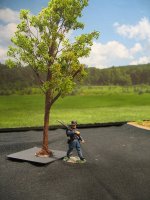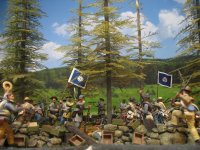Appreciate the comments everyone, the trees are a combination of kits I built, ready made trees from The Scenic Factory and custom trees I made from scratch. There are 15 full sized trees in this diorama. The pine forest bed was also made with a combination Scenic Factory products and then customized to match the trees. I used magnets in the base so that the trees can be removed from the base for storage. Glad you liked them. Working on new large deciduous trees for the fall diorama. I could show that work in progress if you are interested.
The lab is about 600 square feet and is completely devoted to toy soldiers and dioramas. It is a great set up. I also have a separate painting and coating space in the garage in addition to the lab. in total it is about 1,000 square feet. It was one of the "must haves" in our retirement home. I have a number of my past diorama's disassembled and wrapped in plastic for potential future use, some like the Franklin series unfortunately did not survive the move up here to our retirement home and were given a modern Viking recycling funeral.
I started this diorama concept about a year ago and like the last one, will use on of Don Troiani's prints as a basis. This one is taking a lot of time because of all of the custom building and tweeks to make it better than the last one.
Glad you like the direction this is going. Appreciate the likes and positive comments. Stay tuned. Chris




![IMG_2560[1]a.jpg IMG_2560[1]a.jpg](https://forum.treefrogtreasures.com/data/attachments/158/158216-a6f7c19061e96d0a1afd42a6620f7f4e.jpg)
![IMG_2561[1].jpg IMG_2561[1].jpg](https://forum.treefrogtreasures.com/data/attachments/158/158217-c832395aad570af0b5ba9cf2b578a2a2.jpg)
![IMG_2596[1].jpg IMG_2596[1].jpg](https://forum.treefrogtreasures.com/data/attachments/158/158218-96df888e486b0921d69212c9a07a7c31.jpg)
![IMG_2604[1].jpg IMG_2604[1].jpg](https://forum.treefrogtreasures.com/data/attachments/158/158223-7777e30947318eb10fccb6682586339a.jpg)
![IMG_2605[1].jpg IMG_2605[1].jpg](https://forum.treefrogtreasures.com/data/attachments/158/158224-09d3274281a3d6c3f2c5b8acbf662e6e.jpg)
![IMG_2644[1].jpg IMG_2644[1].jpg](https://forum.treefrogtreasures.com/data/attachments/158/158225-d44f28fbf3ad2cbfe26cf5610ee1deba.jpg)
![IMG_2645[1].jpg IMG_2645[1].jpg](https://forum.treefrogtreasures.com/data/attachments/158/158226-b40eb2c7e24d859526020df2a5cd6760.jpg)
![IMG_2646[1].jpg IMG_2646[1].jpg](https://forum.treefrogtreasures.com/data/attachments/158/158227-08f2aebf579d507b72bc95b36016a4c6.jpg)
![IMG_2648[1].jpg IMG_2648[1].jpg](https://forum.treefrogtreasures.com/data/attachments/158/158228-b2547ba8b420724e07fe92d95174309e.jpg)
![IMG_2649[1].jpg IMG_2649[1].jpg](https://forum.treefrogtreasures.com/data/attachments/158/158229-ead2e3dce6291d997cbc607ee16419b0.jpg)
![IMG_2651[1].jpg IMG_2651[1].jpg](https://forum.treefrogtreasures.com/data/attachments/158/158230-6e1687075bebc4bac214107822210d9c.jpg)